Exhibit 99.1

Inflammation and Immunology Repair Two Platforms in the Clinic: XPro and INKmune INMB Nasdaq November 2024 v4b
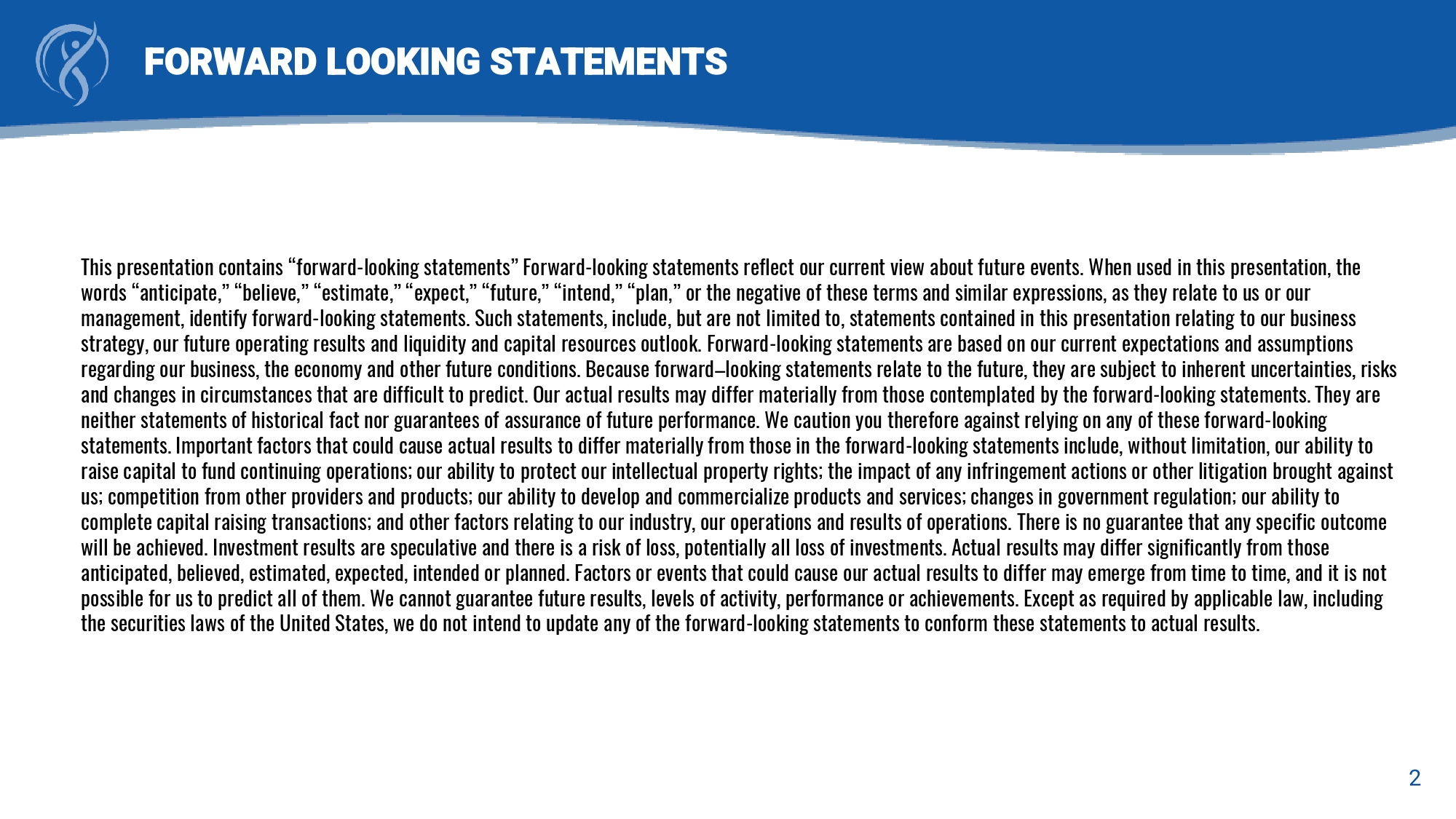
2 FORWARD LOOKING STATEMENTS This presentation contains “forward - looking statements” Forward - looking statements reflect our current view about future events. When used in this presentation, the words “anticipate,” “believe,” “estimate,” “expect,” “future,” “intend,” “plan,” or the negative of these terms and similar e xpr essions, as they relate to us or our management, identify forward - looking statements. Such statements, include, but are not limited to, statements contained in this presentation relating to our business strategy, our future operating results and liquidity and capital resources outlook. Forward - looking statements are based on our current expectations and assumptions regarding our business, the economy and other future conditions. Because forward – looking statements relate to the future, they a re subject to inherent uncertainties, risks and changes in circumstances that are difficult to predict. Our actual results may differ materially from those contemplated by the forward - looking statements. They are neither statements of historical fact nor guarantees of assurance of future performance. We caution you therefore against rel yin g on any of these forward - looking statements. Important factors that could cause actual results to differ materially from those in the forward - looking statements include, without limitation, our ability to raise capital to fund continuing operations; our ability to protect our intellectual property rights; the impact of any infri nge ment actions or other litigation brought against us; competition from other providers and products; our ability to develop and commercialize products and services; changes in go vernment regulation; our ability to complete capital raising transactions; and other factors relating to our industry, our operations and results of operations. The re is no guarantee that any specific outcome will be achieved. Investment results are speculative and there is a risk of loss, potentially all loss of investments. Actual re sults may differ significantly from those anticipated, believed, estimated, expected, intended or planned. Factors or events that could cause our actual results to dif fer may emerge from time to time, and it is not possible for us to predict all of them. We cannot guarantee future results, levels of activity, performance or achievements. Exc ept as required by applicable law, including the securities laws of the United States, we do not intend to update any of the forward - looking statements to conform these stat ements to actual results.
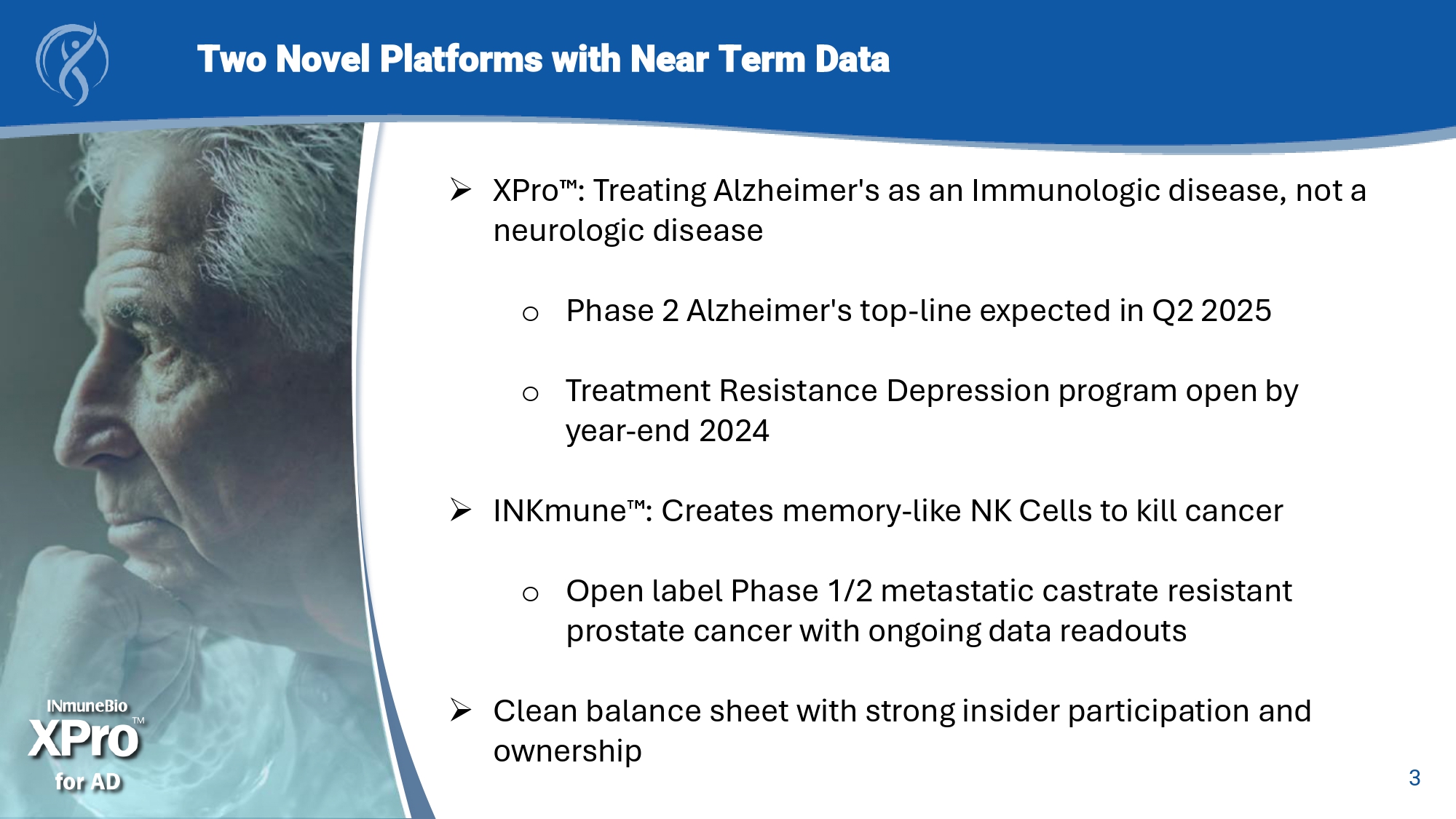
a 3 Two Novel Platforms with Near Term Data » XPro : Treating Alzheimer's as an Immunologic disease, not a neurologic disease o Phase 2 Alzheimer's top - line expected in Q2 2025 o Treatment Resistance Depression program open by year - end 2024 » INKmune : Creates memory - like NK Cells to kill cancer o Open label Phase 1/2 metastatic castrate resistant prostate cancer with ongoing data readouts » Clean balance sheet with strong insider participation and ownership
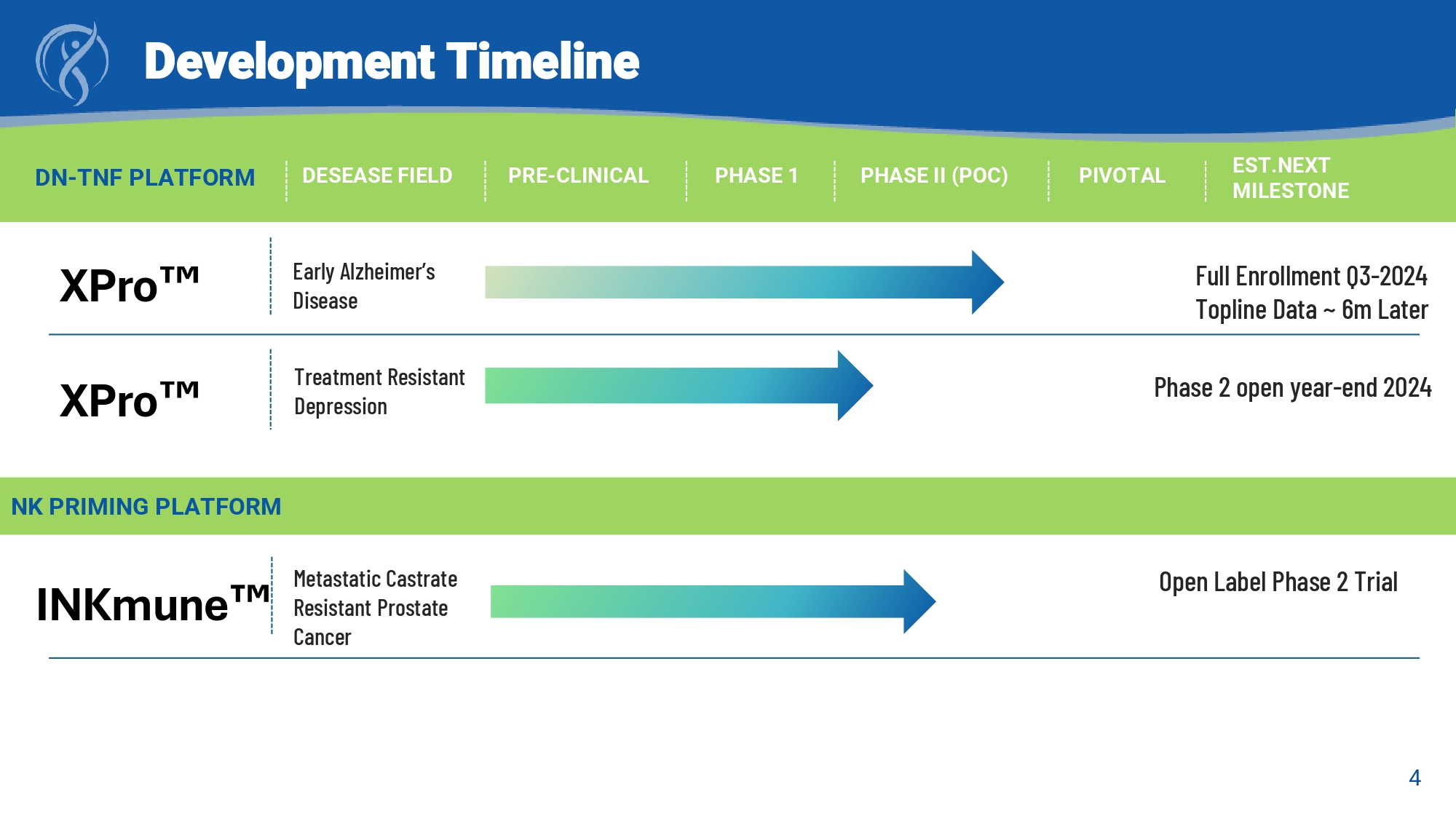
4 DN - TNF PLATFORM DESEASE FIELD PRE - CLINICAL PHASE 1 PHASE II (POC) PIVOTAL EST.NEXT MILESTONE Early Alzheimer’s Disease Full Enrollment Q3 - 2024 Topline Data ~ 6m Later Treatment Resistant Depression Phase 2 open year - end 2024 NK PRIMING PLATFORM Metastatic Castrate Resistant Prostate Cancer Open Label Phase 2 Trial Development Timeline XPro XPro INKmune
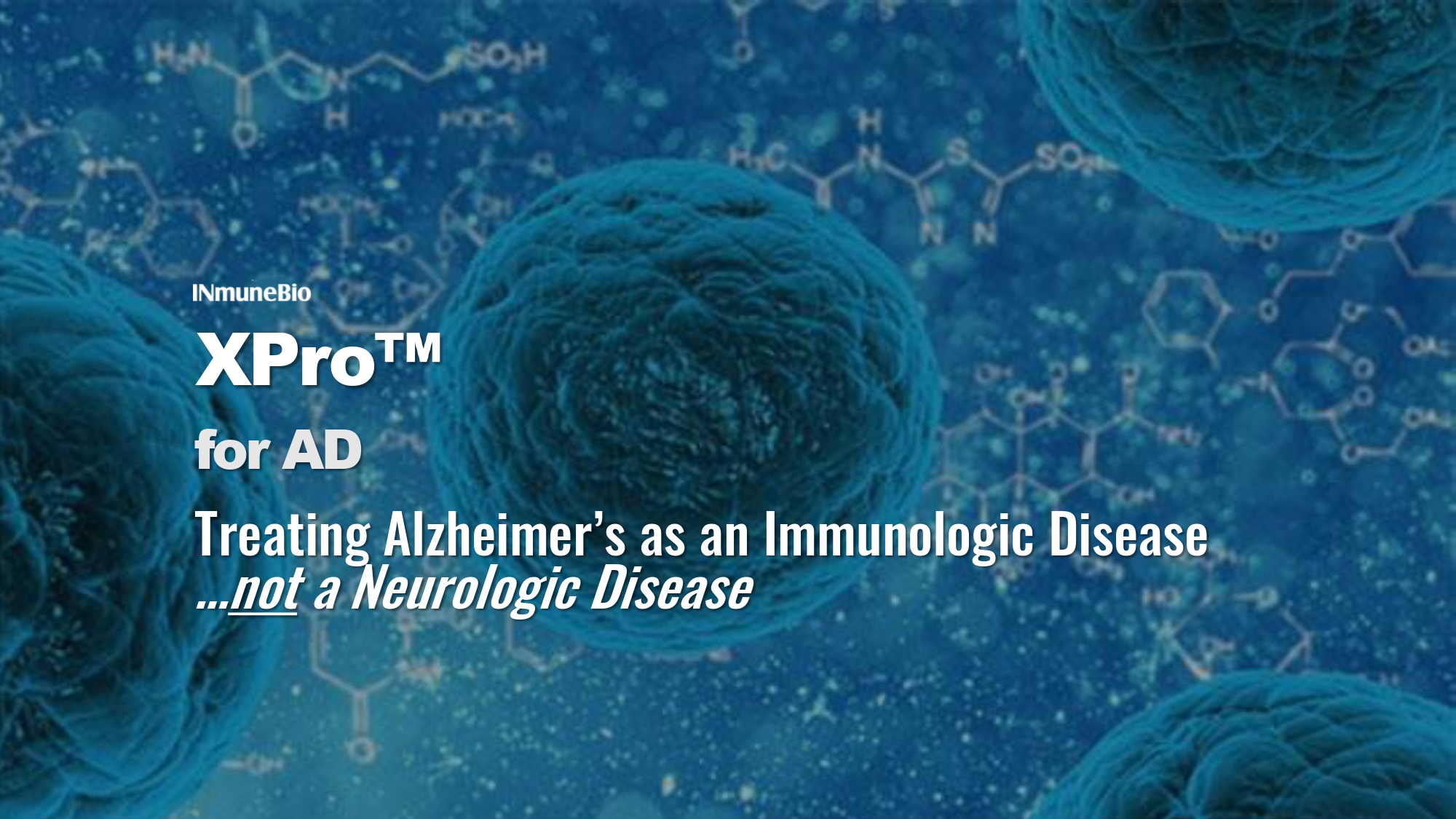
5 Treating Alzheimer’s as an Immunologic Disease … not a Neurologic Disease for AD XPro
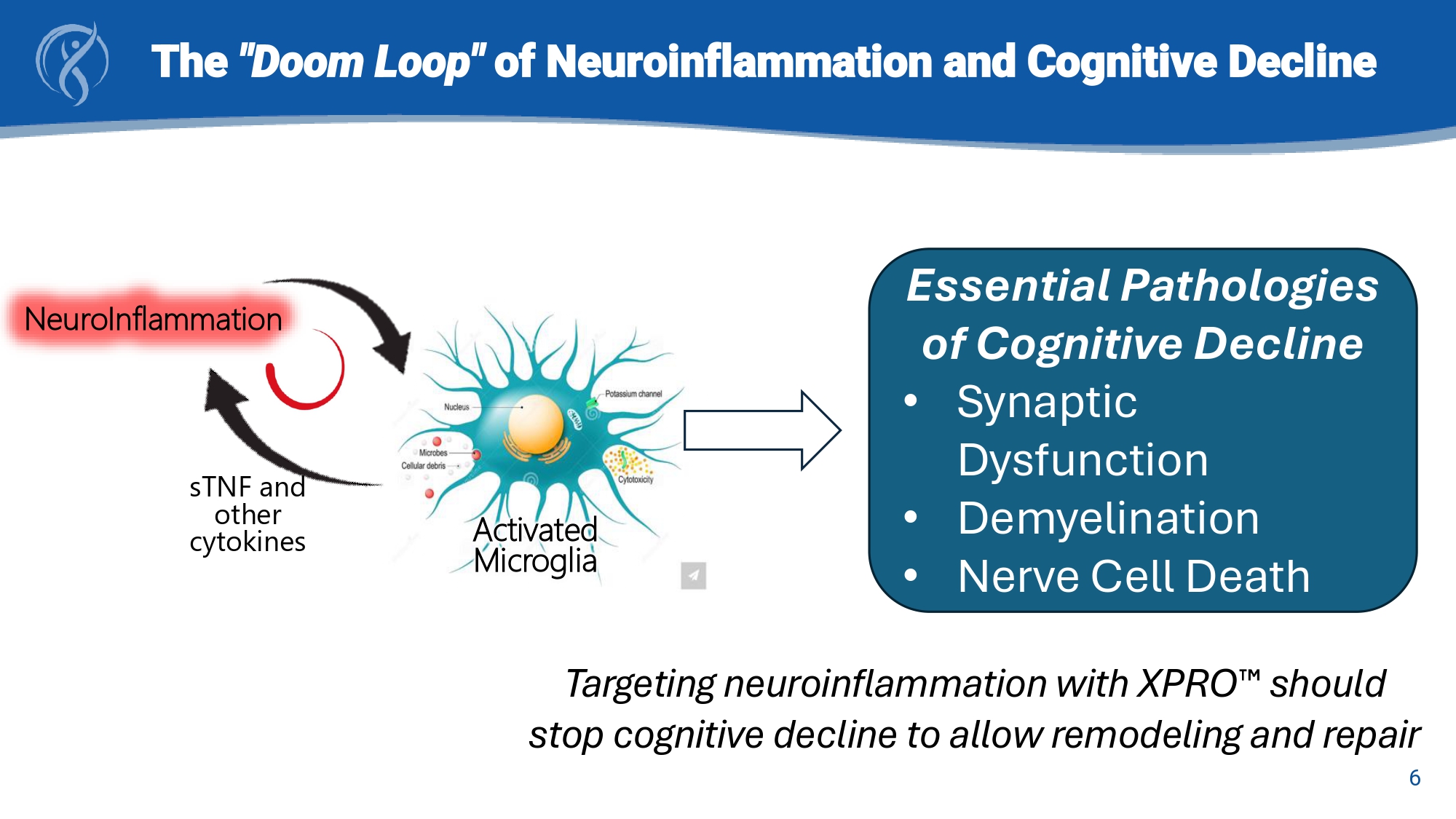
6 Activated Microglia sTNF and other cytokines NeuroInflammation Essential Pathologies of Cognitive Decline • Synaptic Dysfunction • Demyelination • Nerve Cell Death Targeting neuroinflammation with XPRO should stop cognitive decline to allow remodeling and repair The "Doom Loop" of Neuroinflammation and Cognitive Decline
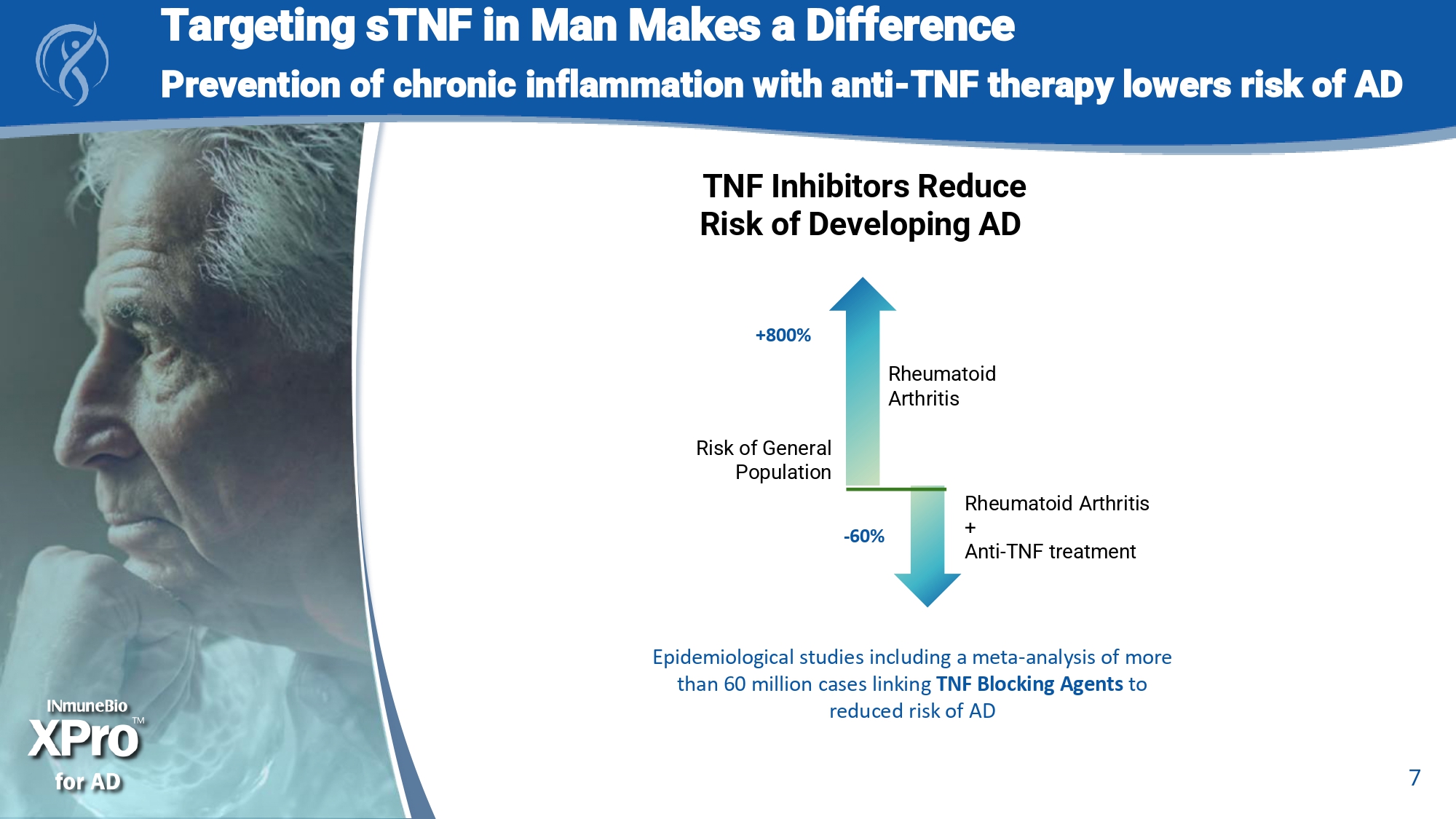
a 7 Epidemiological studies including a meta - analysis of more than 60 million cases linking TNF Blocking Agents to reduced risk of AD +800% Rheumatoid Arthritis Risk of General Population Rheumatoid Arthritis + Anti - TNF treatment - 60% TNF Inhibitors Reduce Risk of Developing AD Targeting sTNF in Man Makes a Difference Prevention of chronic inflammation with anti - TNF therapy lowers risk of AD

8 • sTNF drives expression and accumulation of amyloid • Targeting sTNF should stop amyloid deposition Aβ Amyloid plaque 3 Blasko et al.1999 β - secretase β - secretase 2 APP 1 Lahiri et al. 2003 Soluble TNF Drives Pathology of Alzheimer's sTNF drives neuroinflammation that promotes amyloid plaque deposition Yamamoto et al., 2007

9 Neutralizing sTNF with XPro Decreases Neuroinflammation Dose - dependent reduction of CSF biomarkers of neuroinflammation in AD patients CSF Phase I results using Olink ® Target 48 Cytokine assay in CSF *1 mg/kg group (N=6)
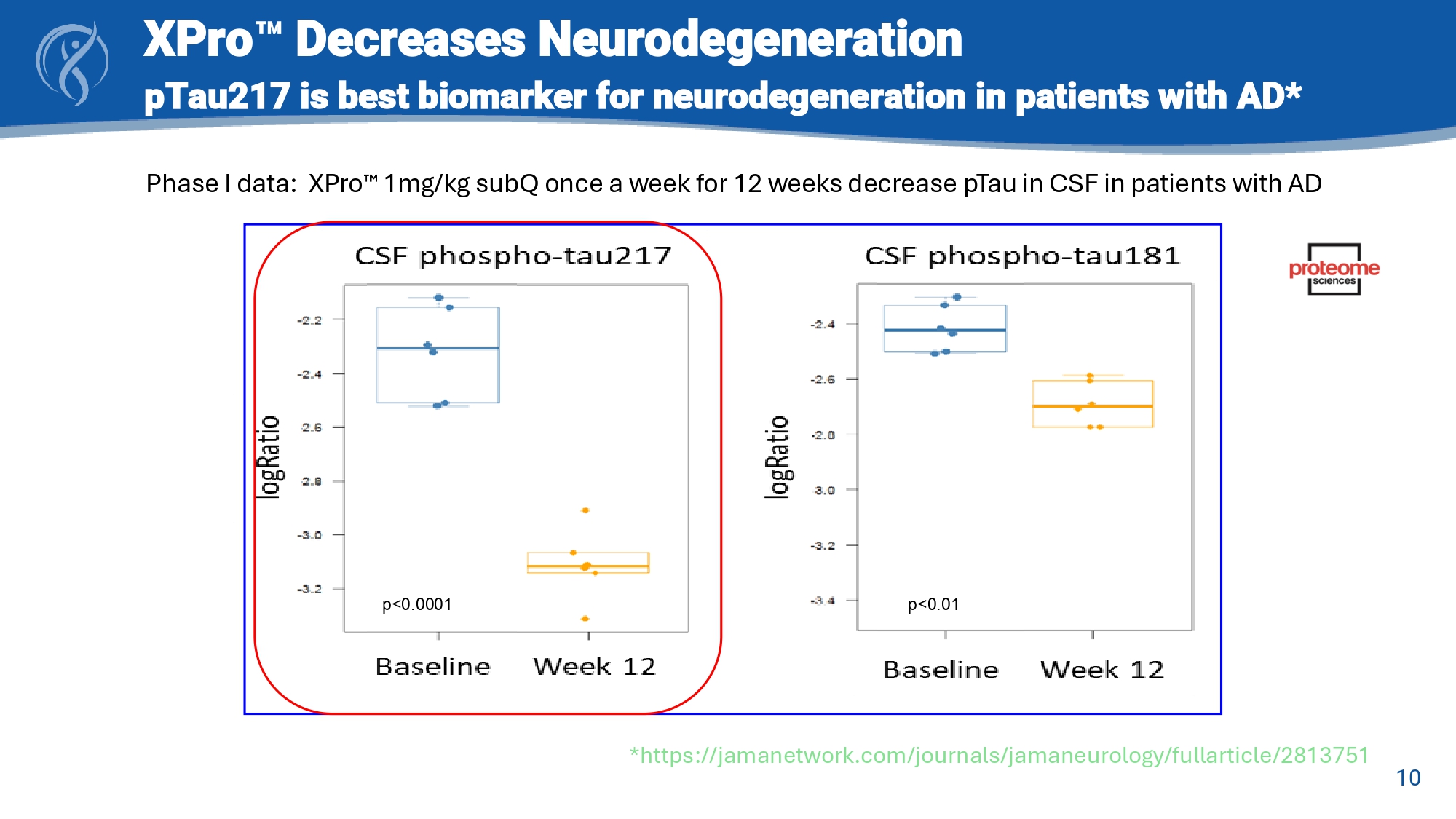
10 XPro Decreases Neurodegeneration pTau217 is best biomarker for neurodegeneration in patients with AD* p<0.0001 p<0.01 Phase I data: XPro 1mg/kg subQ once a week for 12 weeks decrease pTau in CSF in patients with AD * https://jamanetwork.com/journals/jamaneurology/fullarticle/2813751
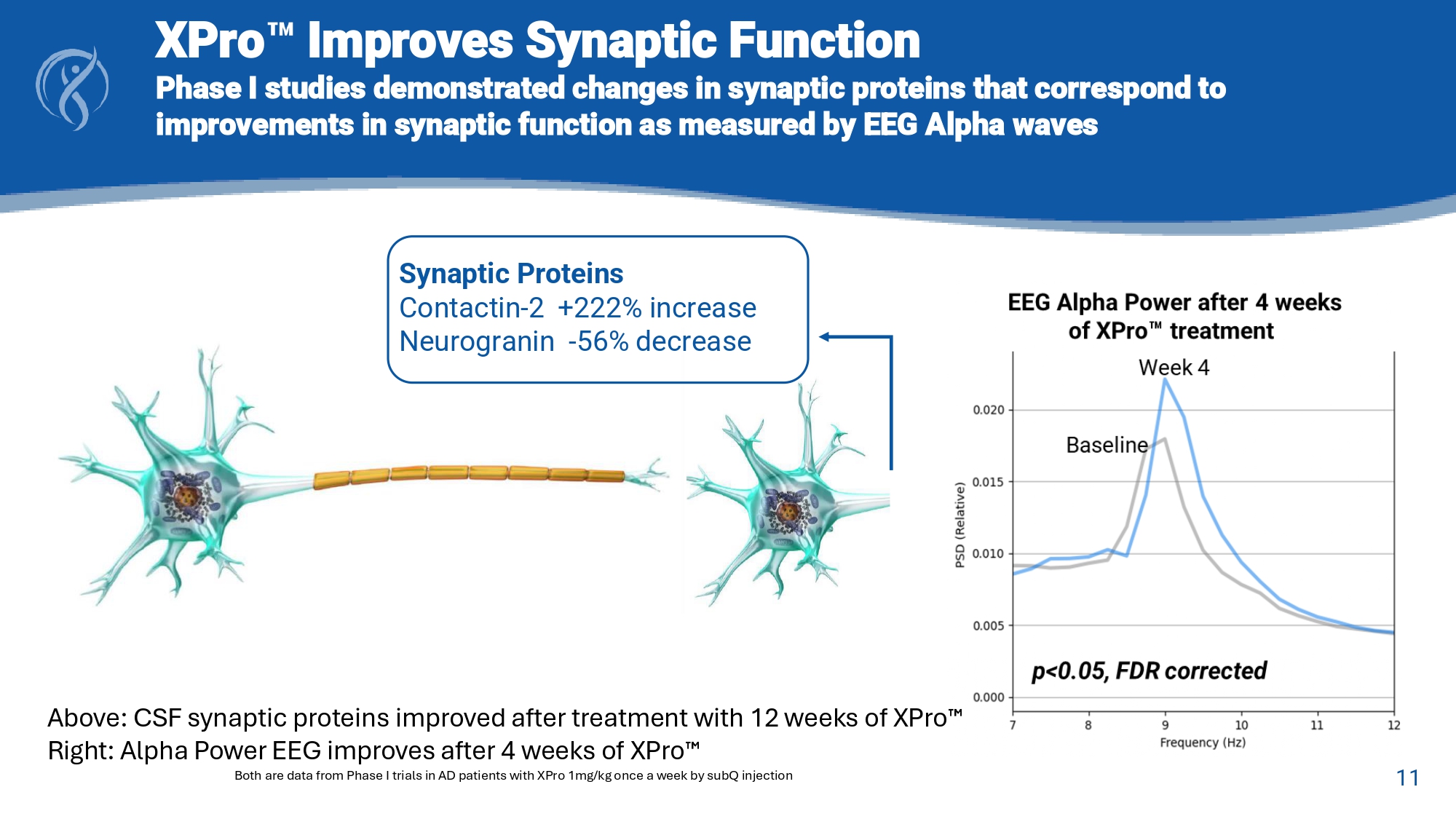
11 XPro Improves Synaptic Function Phase I studies demonstrated changes in synaptic proteins that correspond to improvements in synaptic function as measured by EEG Alpha waves Synaptic Proteins Contactin - 2 +222% increase Neurogranin - 56% decrease Above: CSF synaptic proteins improved after treatment with 12 weeks of XPro Right: Alpha Power EEG improves after 4 weeks of XPro Both are data from Phase I trials in AD patients with XPro 1mg/kg once a week by subQ injection
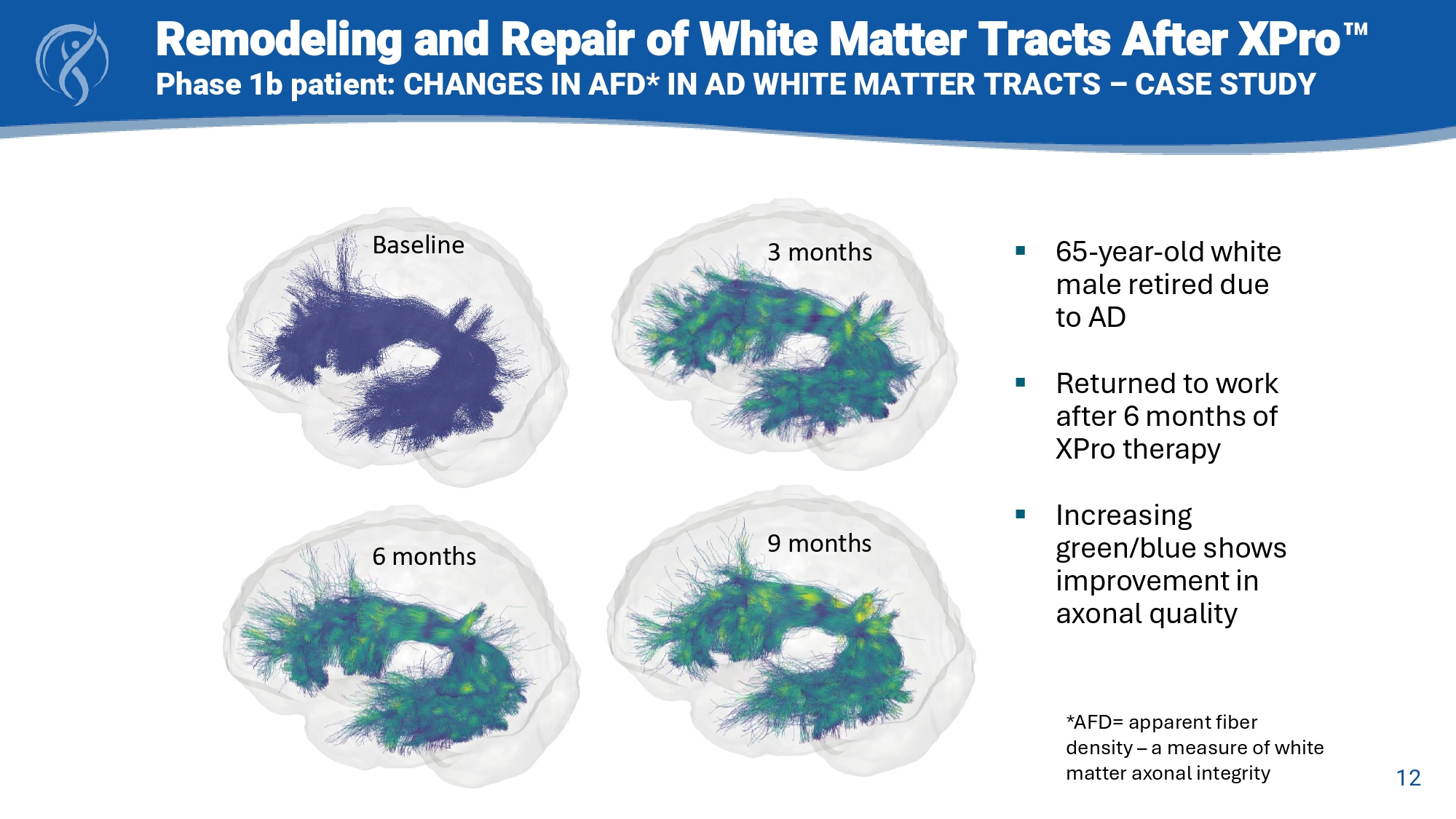
12 Baseline 3 months 6 months 9 months ▪ 65 - year - old white male retired due to AD ▪ Returned to work after 6 months of XPro therapy ▪ Increasing green/blue shows improvement in axonal quality Remodeling and Repair of White Matter Tracts After XPro Phase 1b patient: CHANGES IN AFD* IN AD WHITE MATTER TRACTS – CASE STUDY *AFD= apparent fiber density – a measure of white matter axonal integrity
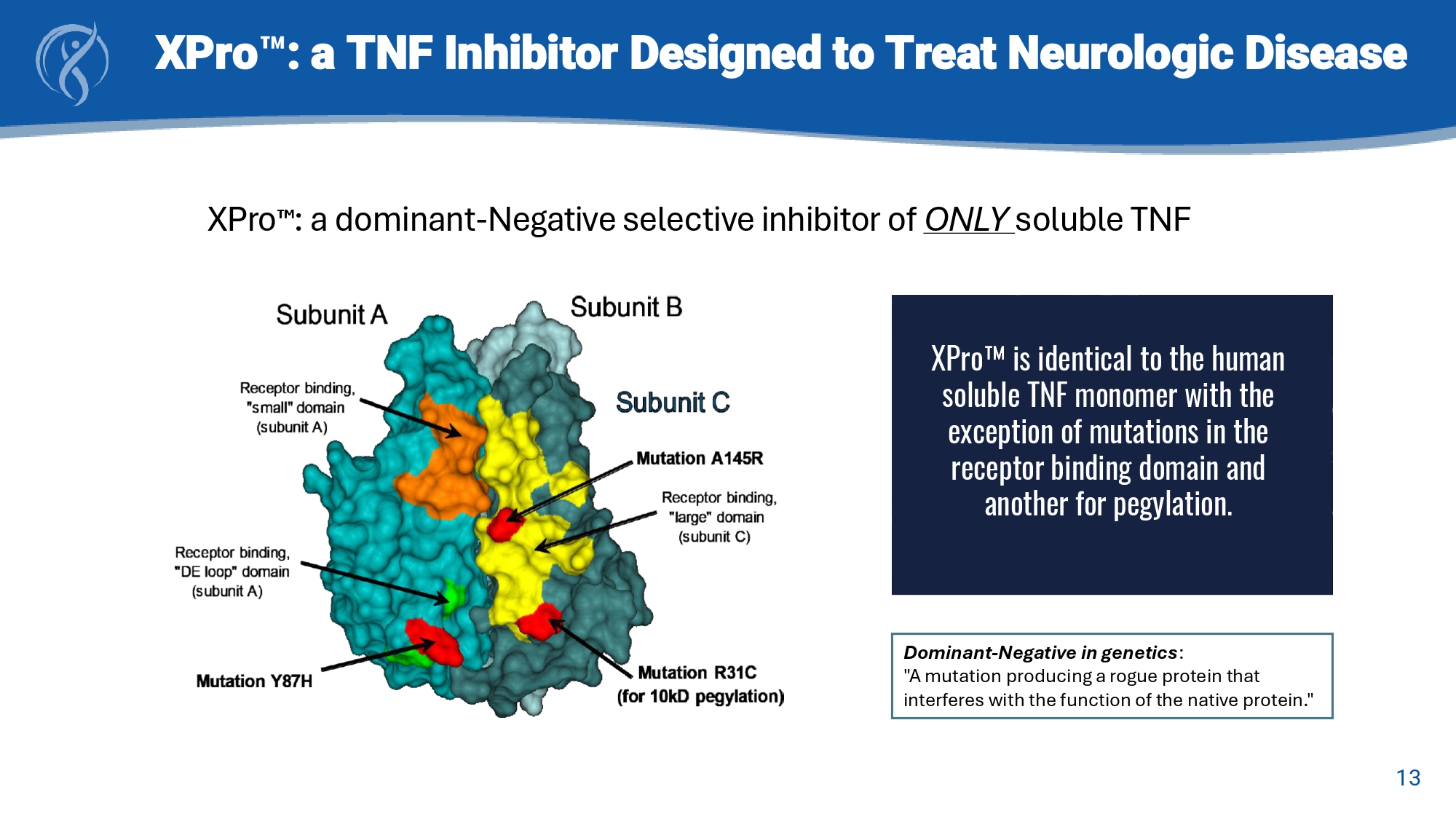
13 XPro : a TNF Inhibitor Designed to Treat Neurologic Disease XPro i s identical to the human soluble TNF monomer with the exception of mutations in the receptor binding domain and another for pegylation . XPro : a dominant - Negative selective inhibitor of ONLY soluble TNF Dominant - Negative in genetics : "A mutation producing a rogue protein that interferes with the function of the native protein. "

14 TNF: Two Cytokines, Same Name, Opposite Effects Currently approved TNF inhibitors block both types of TNF causing immunosuppression and demyelination Soluble TNF cause inflammation, cell death and demyelination Transmembrane TNF promotes immune function, is neuroprotective and improves synaptic plasticiy
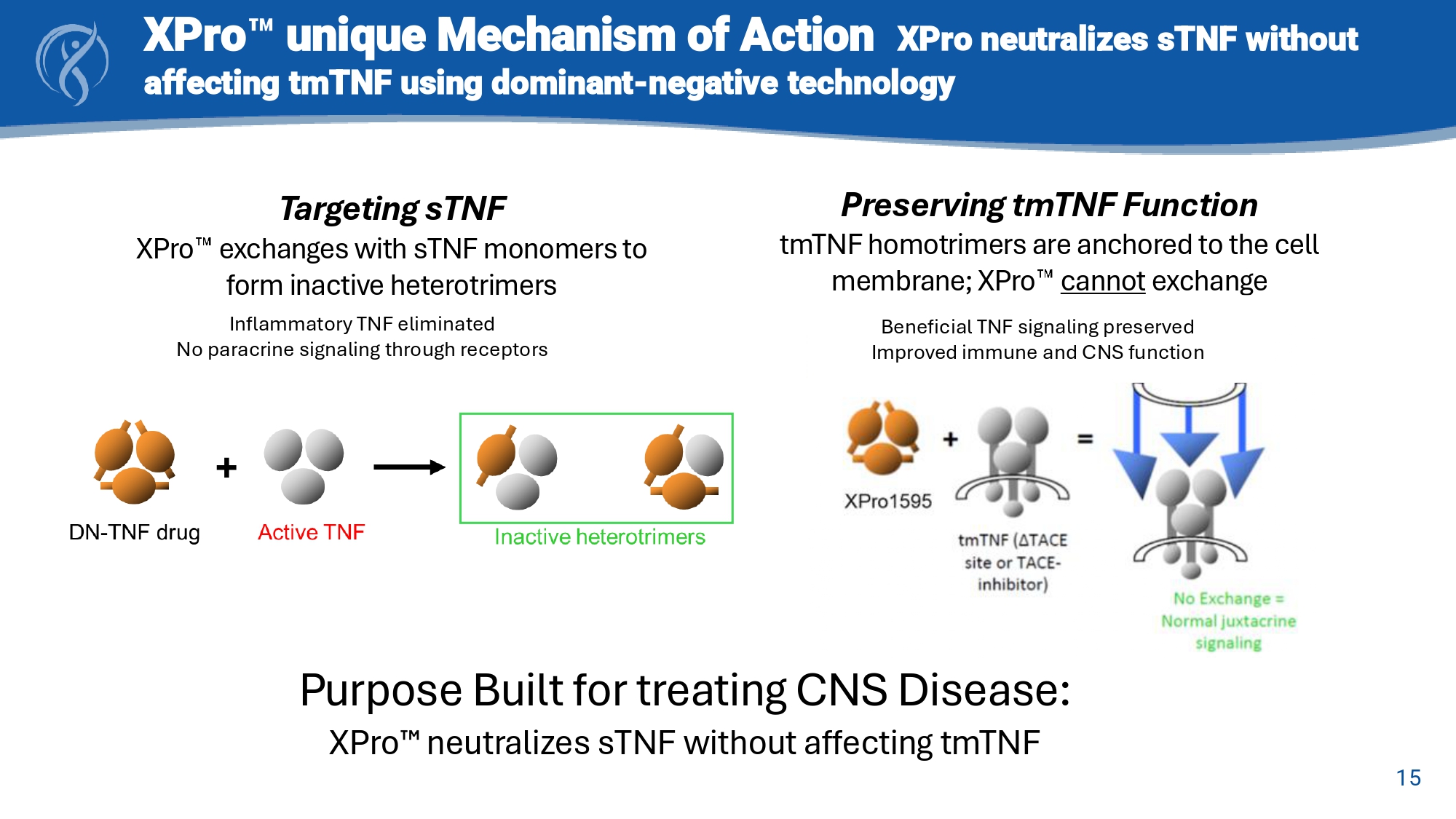
15 XPro unique Mechanism of Action XPro neutralizes sTNF without affecting tmTNF using dominant - negative technology Targeting sTNF XPro exchanges with sTNF monomers to form inactive heterotrimers Inflammatory TNF eliminated No paracrine signaling through receptors Preserving tmTNF Function tmTNF homotrimers are anchored to the cell membrane; XPro cannot exchange Purpose Built for treating CNS Disease: XPro neutralizes sTNF without affecting tmTNF Beneficial TNF signaling preserved Improved immune and CNS function

16 • Currently approved TNF inhibitors are contraindicated in treatment of neurologic disease such as AD • promote demyelination (yellow arrow) • promote axon degeneration (white arrows) • XPro promotes remyelination and axonal regeneration Karamita; Therapeutic inhibition of soluble brain TNF promotes remyelination by increasing myelin phagocytosis by microglia. https://doi.org/10.1172/jci.insight.87455 Etanercept XP ro Myelin Axons XPro is the only TNF inhibitor that is safe for the Brain FDA label on currently approved TNF inhibitors recommend against use for CNS disease

17 Phase 2 Trial of XPro in Patients with Early Alzheimer's Disease Primary Endpoint □ EMACC Secondary Endpoints □ CDR, ECog □ ADL, NPI □ Blood □ MRI □ Safety Treatment □ 2:1 ( XPro :Placebo) □ 1 mg/kg XPro weekly subQ injection Unique design elements □ small and short □ enrichment, □ precise cognitive end - point
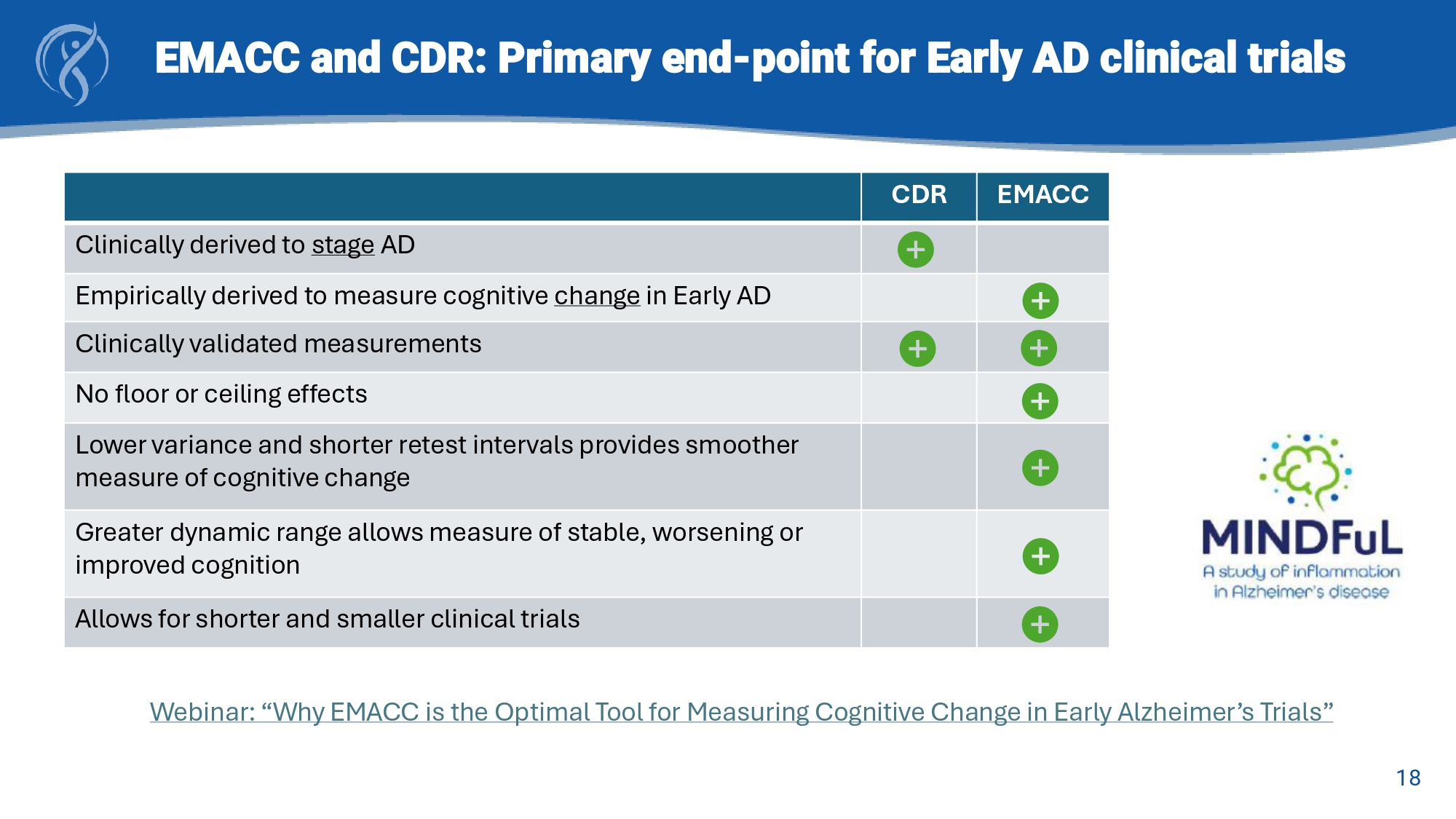
18 EMACC and CDR: Primary end - point for Early AD clinical trials EMACC CDR Clinically derived to stage AD Empirically derived to measure cognitive change in Early AD Clinically validated measurements No floor or ceiling effects Lower variance and shorter retest intervals provides smoother measure of cognitive change Greater dynamic range allows measure of stable, worsening or improved cognition Allows for shorter and smaller clinical trials Webinar: “Why EMACC is the Optimal Tool for Measuring Cognitive Change in Early Alzheimer’s Trials”
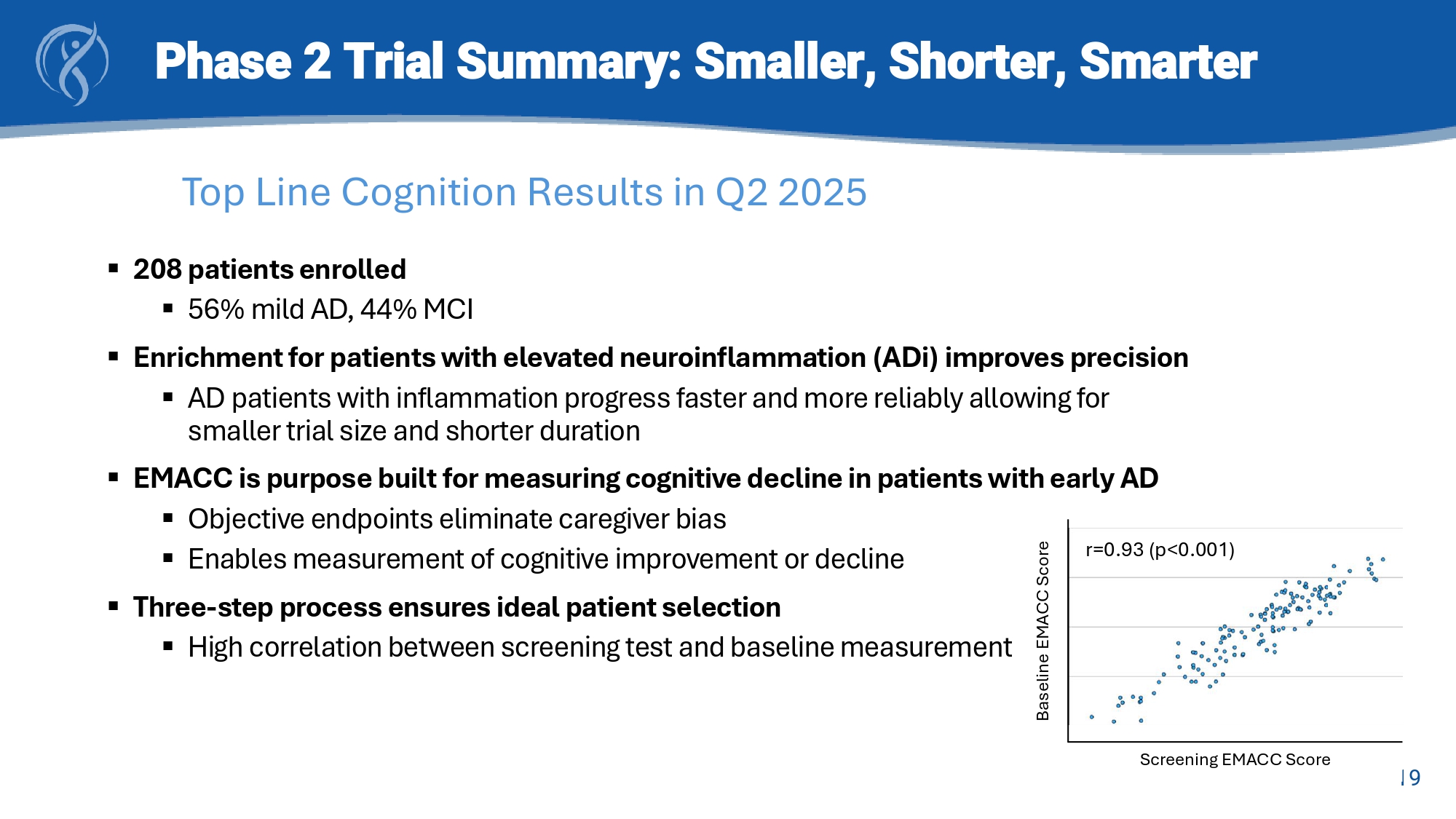
19 Phase 2 Trial Summary: Smaller, Shorter, Smarter ▪ 208 patients enrolled ▪ 56% mild AD, 44% MCI ▪ Enrichment for patients with elevated neuroinflammation ( ADi ) improves precision ▪ AD patients with inflammation progress faster and more reliably allowing for smaller trial size and shorter duration ▪ EMACC is purpose built for measuring cognitive decline in patients with early AD ▪ Objective endpoints eliminate caregiver bias ▪ Enables measurement of cognitive improvement or decline ▪ Three - step process ensures ideal patient selection ▪ High correlation between screening test and baseline measurement r=0.93 (p<0.001) Baseline EMACC Score Screening EMACC Score Top Line Cognition Results in Q2 2025
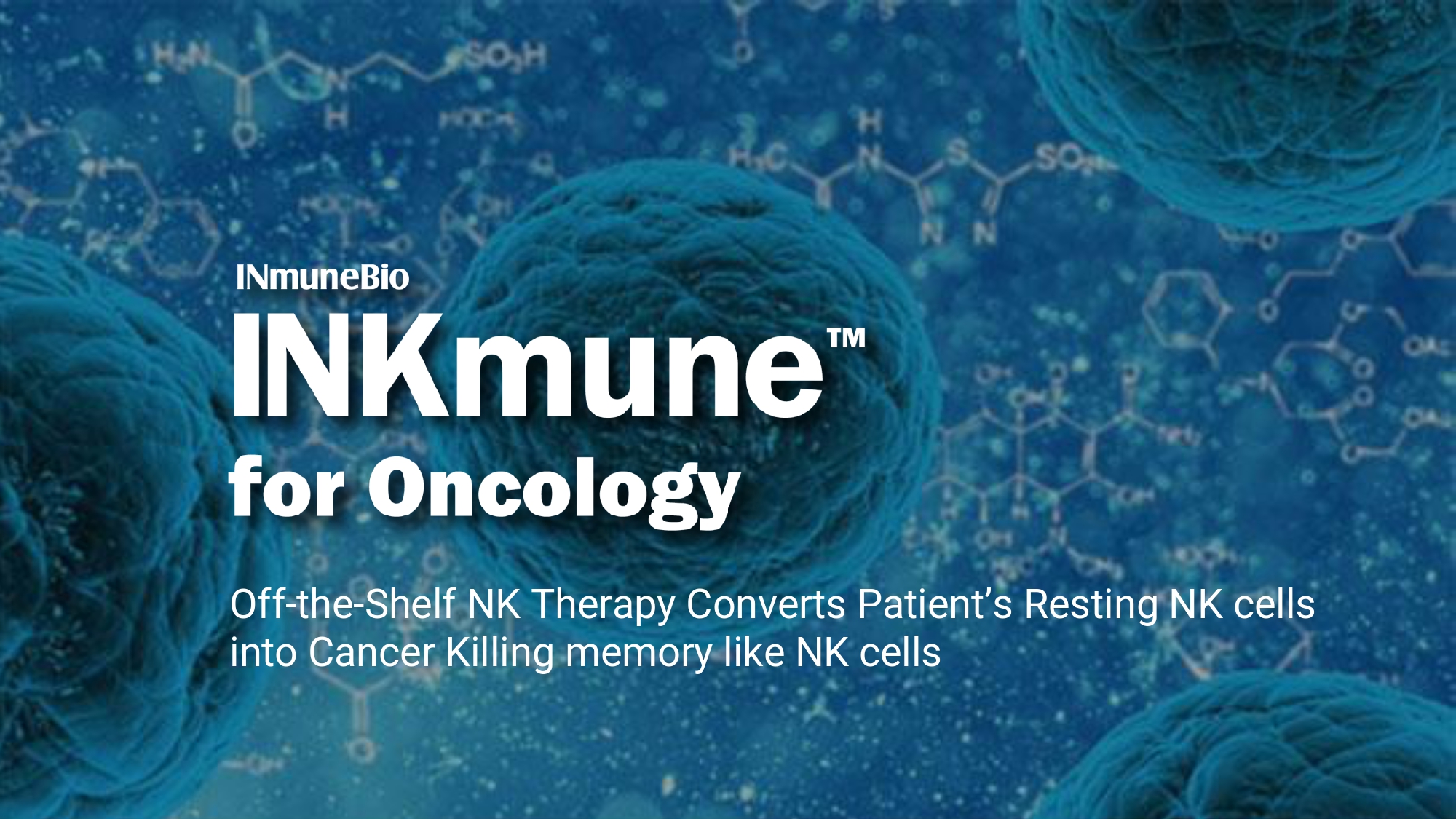
20 Off - the - Shelf NK Therapy Converts Patient’s Resting NK cells into Cancer Killing memory like NK cells

21 Problem: Value Proposition (efficacy vs toxicity) of treatments for mCPRC is Poor • The Facts: • Incidence of prostate cancer increasing - >50,000 mCRPC patients in US • Current therapies average <6 month survival benefit • Safety profile not ideal in patients (avg age: 76 years old) Severe (grade3 or 4) Total Toxicity 82% 94% Neutropenia n/a 8% Febrile Neutropenia 6% 47% Diarrhea 2% 34% Nausea 5% 37% Fatigue INKmune toxicity – none reported to date INKmune (treatment of day 1,8, and15) 20min infusion via peripheral vein Patient goes home after 2 hours
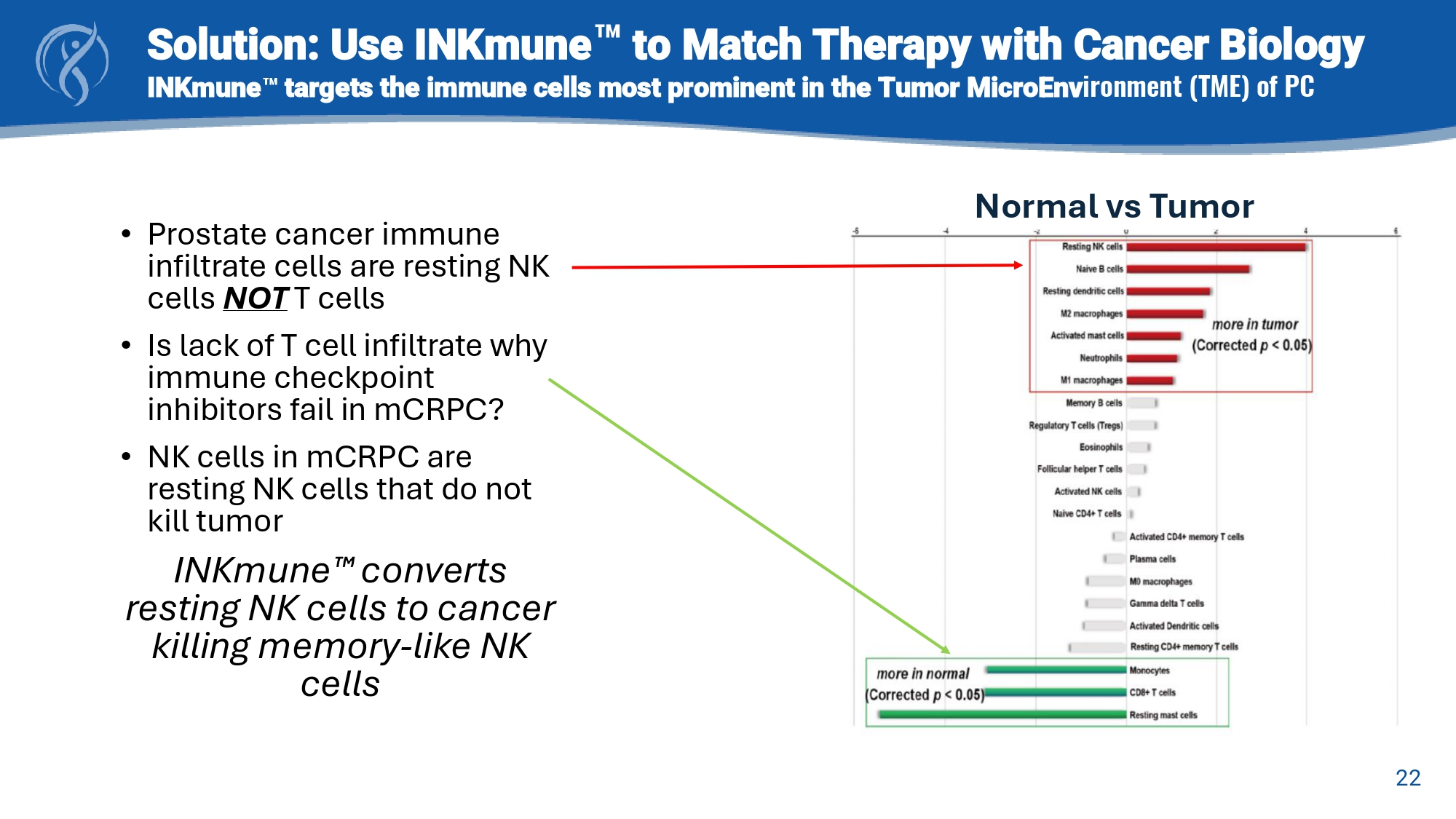
22 Solution: Use INKmune to Match Therapy with Cancer Biology INKmune targets the immune cells most prominent in the Tumor MicroEnv ironment (TME) of PC • Prostate cancer immune infiltrate cells are resting NK cells NOT T cells • Is lack of T cell infiltrate why immune checkpoint inhibitors fail in mCRPC ? • NK cells in mCRPC are resting NK cells that do not kill tumor INKmune converts resting NK cells to cancer killing memory - like NK cells Normal vs Tumor

23 INKmune Primed NK Cells “Fitter” Than Cytokine Primed NK Cells rNK LAK - 15 CIML - NK INKMUNE - TpNK proteomics G A T B G A T C G F M 2 H A R S 1 H A R S 2 L A R S 2 M R P L 1 0 M R P L 1 6 M R P L 2 M R P L 2 3 M R P L 4 7 M R P L 5 1 M R P L 5 7 M R P S 1 1 M R P S 1 2 M R P S 1 5 M R P S 1 6 M R P S 1 7 M R P S 1 8 A M R P S 1 8 B M R P S 1 8 C M R P S 2 M R P S 2 1 M R P S 2 4 M R P S 3 4 M R P S 6 M R P S 7 N D U F A 7 N O A 1 P T C D 3 Q R S L 1 R A R S 2 -2 -1 0 1 2 3 Change in mitochondrial survival proteins following priming Mitochondrial survival proteins L o g c h a n g e f r o m r N K ( A v e r a g e L o g r a t i o ) TpNK CIML IL15 R e s t i n g N K c e l l s T i M L - N K C i M L - N K 0.00 0.05 0.10 0.15 0.20 O C R ( p m o l e s / m i n ) Basal Mitochondria Respiration R e s t i n g N K c e l l s T i M L - N K C i M L - N K 0.0 0.1 0.2 0.3 O C R ( p m o l e s / m i n ) Maximal Mitochondria Respiration * studies of human NK cells targeting human prostate cancer cells
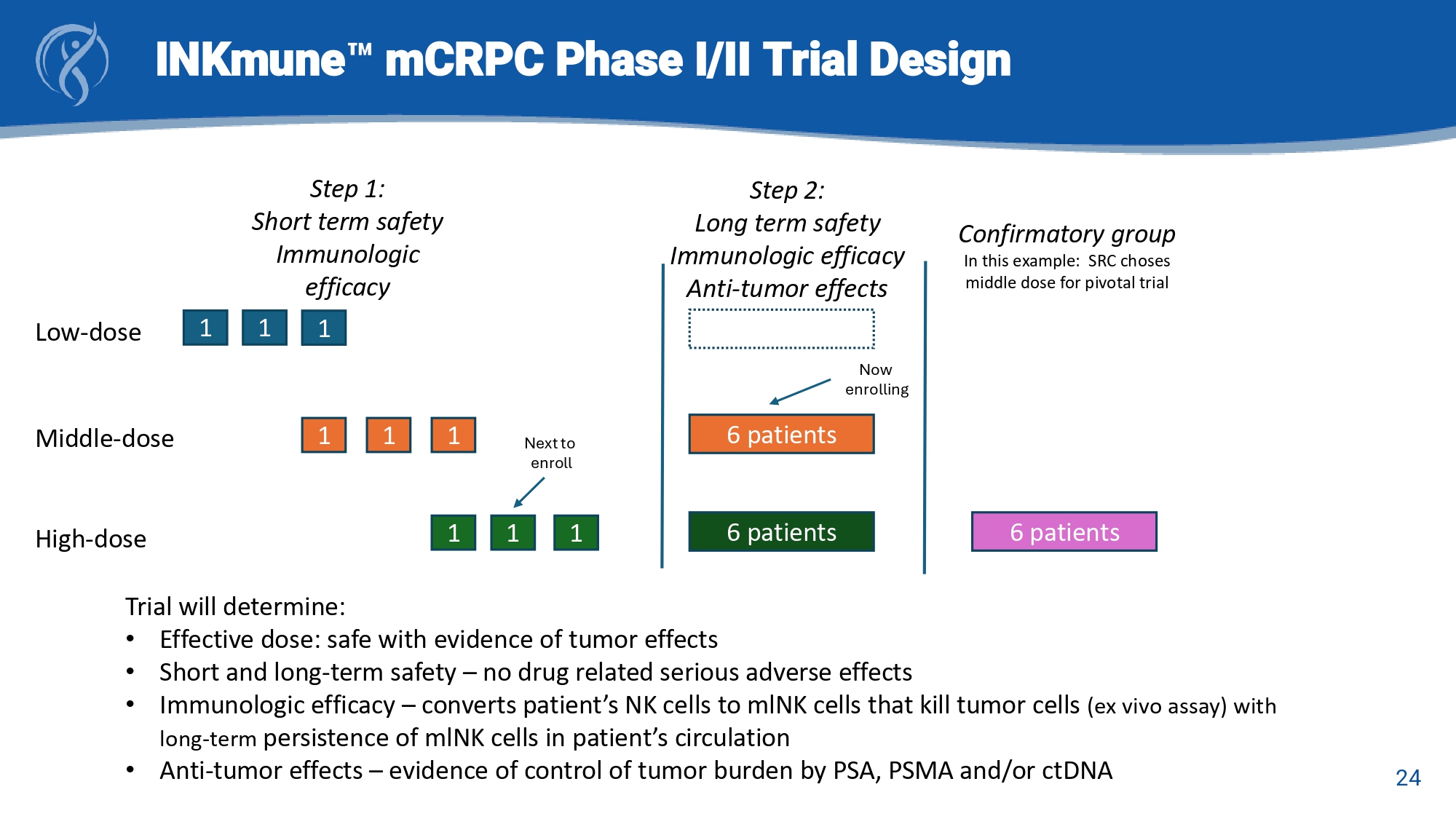
24 INKmune mCRPC Phase I/II Trial Design Low - dose Middle - dose High - dose 1 1 1 1 1 1 1 1 1 Step 1: Short term safety Immunologic efficacy 6 patients 6 patients Step 2: Long term safety Immunologic efficacy Anti - tumor effects 6 patients Confirmatory group In this example: SRC choses middle dose for pivotal trial Trial will determine: • Effective dose: safe with evidence of tumor effects • Short and long - term safety – no drug related serious adverse effects • Immunologic efficacy – converts patient’s NK cells to mlNK cells that kill tumor cells (ex vivo assay) with long - term persistence of mlNK cells in patient’s circulation • Anti - tumor effects – evidence of control of tumor burden by PSA, PSMA and/or ctDNA Next to enroll Now enrolling
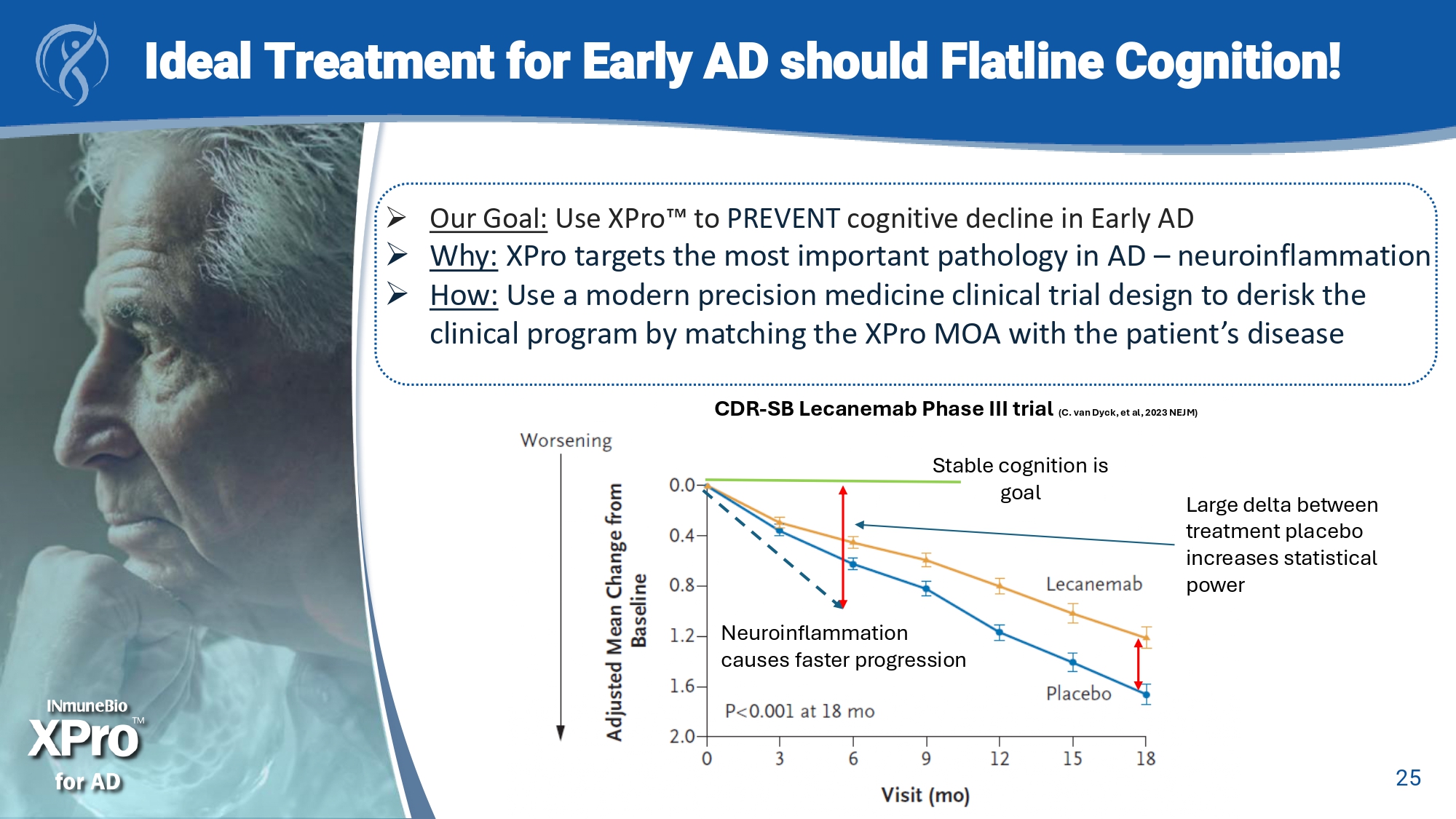
a 25 » Our Goal: Use XPro to PREVENT cognitive decline in Early AD » Why: XPro targets the most important pathology in AD – neuroinflammation » How: Use a modern precision medicine clinical trial design to derisk the clinical program by matching the XPro MOA with the patient’s disease Ideal Treatment for Early AD should Flatline Cognition! CDR - SB Lecanemab Phase III Stable cognition is goal Large delta between treatment placebo increases statistical power Neuroinflammation causes faster progression CDR - SB Lecanemab Phase III trial ( C. van Dyck, et al, 2023 NEJM )

26 Anticipated Milestones in 2024 and 2025 EXPECTED TIMING EVENT Q2 2025 Topline Phase 2 AD Data Q3 2025 End of Phase 2 FDA Meeting AD 2H 2024 Pre - clinical Anti - AB and XPro Data 2H 2024 Initiate Phase 2 TRD Trial 1H 2025 Complete Phase 2 mCRPC Enrollment Ongoing Open Label Phase 2 mCRPC Data Key Upcoming Clinical & Regulatory Milestones
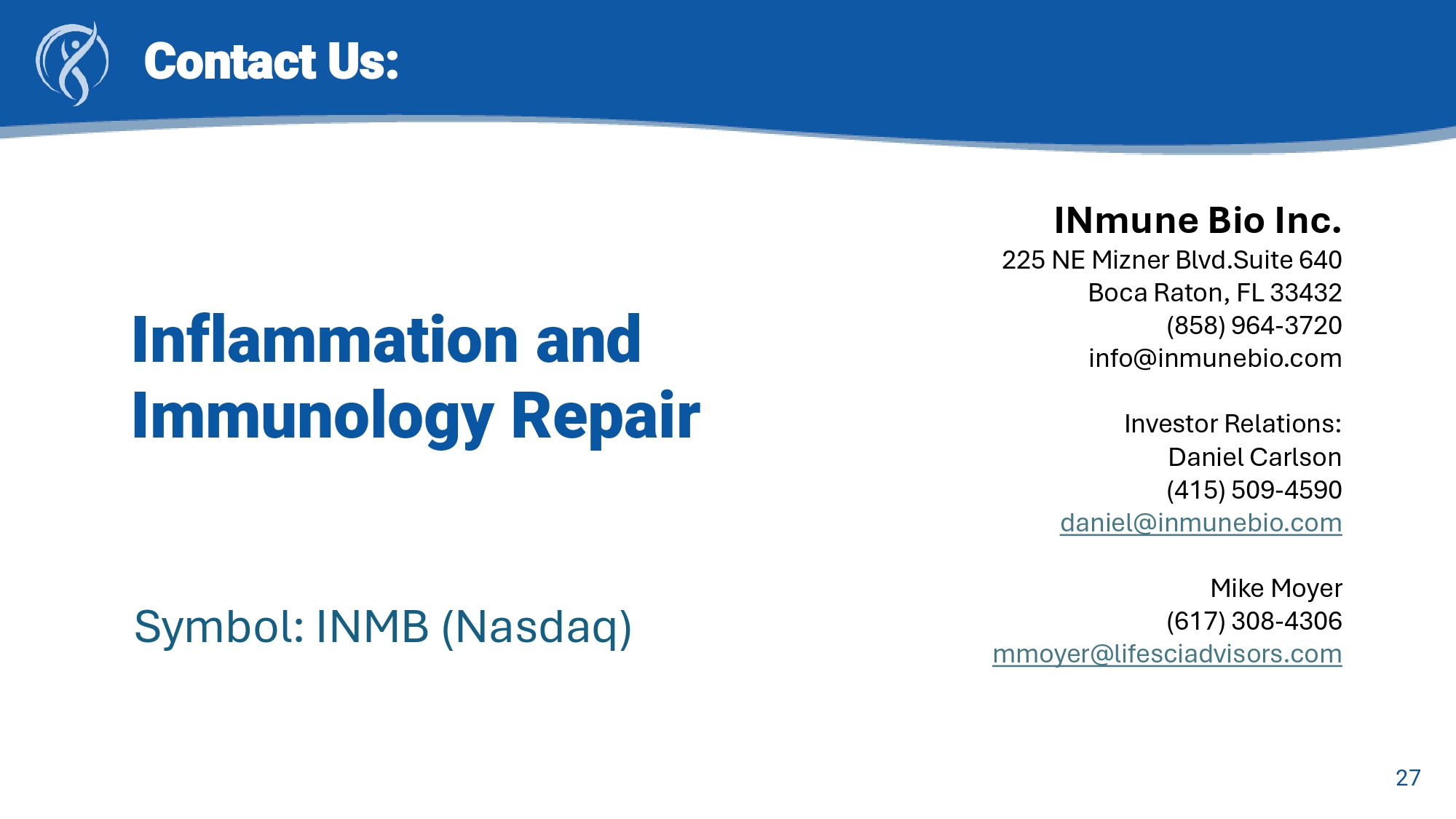
27 Contact Us: INmune Bio Inc. 225 NE Mizner Blvd.Suite 640 Boca Raton, FL 33432 (858) 964 - 3720 info@inmunebio.com Investor Relations: Daniel Carlson (415) 509 - 4590 daniel@inmunebio.com Mike Moyer (617) 308 - 4306 mmoyer@lifesciadvisors.com Symbol: INMB (Nasdaq) Inflammation and Immunology Repair


























